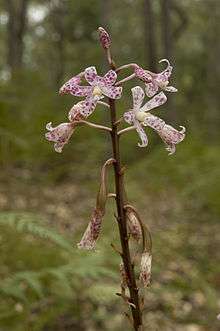Dipodium pardalinum
Dipodium pardalinum, commonly known as spotted hyacinth-orchid[3] or leopard hyacinth-orchid,[4] is a leafless hemiparasitic orchid that is endemic to south-eastern Australia.[3]
| Dipodium pardalinum | |
|---|---|
 | |
| Inflorescence Lower Glenelg National Park, Victoria | |
| Scientific classification | |
| Kingdom: | |
| (unranked): | |
| (unranked): | |
| Order: | |
| Family: | |
| Subfamily: | |
| Tribe: | |
| Genus: | |
| Species: | D. pardalinum |
| Binomial name | |
| Dipodium pardalinum | |
Description
For most of the year, plants are dormant and have no above-ground presence. Below the ground lie fleshy roots. Flower spikes between 40 and 90 cm in height appear between December and March in the species' native range.[5] These racemose inflorescences have 10 to 40 white to pale pink fleshy flowers with dark red spots or blotches. The tepals are strongly recurved and the three-lobed labellum has a line of white hairs.[5]
Taxonomy
The species was formally described in 1996 by botanist David L. Jones in the journal Muelleria. The type specimen was collected in Heathmere, Victoria.[1] The specific epithet pardalinum comes from the Greek word for leopard (pardos) alluding to the spots on the flowers.[5]
Distribution and habitat
Dipodium pardalinum occurs in western Victoria and south-eastern South Australia in open forest with an understorey of bracken or shrubs.[5]
Victoria
It occurs in the west of the state with records from Wombat State Forest, Smythesdale, Creswick, and Heathmere to the north of Portland. A single observation has been reported from The Basin in the Dandenong Ranges.[5]
South Australia
In South Australia, the species occurs from Naracoorte on the Victorian border to the Mount Lofty Ranges.[5] In the Adelaide-Mount Lofty region the species is found in stringybark (Eucalyptus obliqua) woodland growing in association with Acacia myrtifolia, Xanthorrhoea semiplana ssp. tateana and Pteridium esculentum.[4] It does not grow in proximity to other Dipodium species as is the case elsewhere.[4] Prior to recognition as a distinct taxon, this population was regarded as a variety of Dipodium roseum.[4]
In the Deep Creek Conservation Park at the southern end of the Fleurieu Peninsula, the species is threatened by an invasion of broom (Genista monspessulana).[4]
Ecology
Pollination of this species, as for all species in the genus, is by native bees and wasps.[3]
Conservation
The species is listed as "rare" on the Victorian Department of Environment and Primary Industries' advisory list of rare or threatened plants in Victoria and "vulnerable" in South Australia.[6][7]
Cultivation
No leafless species of Dipodium has been sustained in cultivation due to the inability to replicate its association with mycorrhizal fungi in a horticultural context.[3]
References
- "Dipodium pardalinum". Australian Plant Name Index (APNI), IBIS database. Centre for Plant Biodiversity Research, Australian Government. Retrieved 22 January 2014.
- "Dipodium pardalinum D.L.Jones". The Plant List version 1.1. Retrieved 22 January 2013.
- Jones, David L. (2006). A complete guide to native orchids of Australia, including the island territories. Australia: Reed New Holland Publishers. ISBN 9781877069123.
- "Dipodium pardalinum". Adelaide and Mount Lofty Ranges Threatened Species Profile. Department of Environment and Heritage. May 2008.
- Jones, D.L. (2009). "Dipodium pardalinum (Orchidaceae), a new species from Victoria and South Australia". Muelleria. 9: 105–109.
- "Threatened species advisory lists". Department of Environment and Primary Industries. Retrieved 23 January 2014.
- "Census of South Australian Vascular Plants Edition 5.00" (PDF). Botanic Gardens of Adelaide & State Herbarium. 2005.
External links

